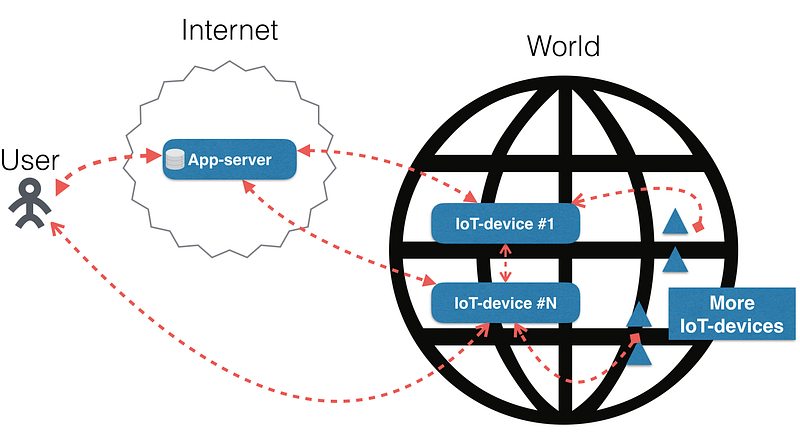Stuff The Internet Says On Scalability For February 10th, 2017
Hey, it's HighScalability time:

- Half a trillion: Apple’s cash machine; 4,000-5,000: collected data points per adult in US; 10 million: gallons of gas UPS saves turning right; 2.27: Tesla 0-60 time; 40: complex steps to phone security; $2.3 billion: VR/AR investment in 2016; 18%: small players make up public cloud services market; 500°C: first chip to survive on Venus; 5 billion: ever notes; 375,000: images from The Metropolitan Museum of Art in public domain; 18 million: queries per minute against Facebook's Beringei database; 159: jobs per immigrant founder; 2.5 miles: whales breach for stronger signal; 10,000x: computers faster in 2035;
- Quotable Quotes:
- @martin_casado: Chinese factory replaces 90% of human workers with robots. Production rises by 250%, defects drop by 80%
- Jure Leskovec: It’s [trolling] a spiral of negativity. Just one person waking up cranky can create a spark and, because of discussion context and voting, these sparks can spiral out into cascades of bad behavior. Bad conversations lead to bad conversations. People who get Continue reading
In-memory noSQL DBMS Client in Big Data Cluster
This is guest post by Sergei Sheinin, creator of the 2DX Web UI Database Cluster Framework, a low latency big data cluster with in-memory noSQL DBMS Web Browser client.
When I began working in the field of data management the disconnect between rigid structure of relational database tables and free form of documents managed by end users and their businesses stood out as a technical and managerial hurdle. On the one hand there were strict definitions of normalized relational database models and unstructured document formats on the other. Often the users in charge of changing document structures held organizational responsibilities far removed from database modeling or programming. On one occasion I was involved in a project where call center operators made on the fly decisions to update a document structure based on phone conversations with customers. Such updates had to be streamed into a relational back-end creating havoc in database structure and build of table columns.
In seeking a permanent solution I researched merits of Entity-Attribute-Value database schema and its applications. This technique proved successful in enabling front end users to modify relational-bound documents through performing updates to structure described in their metadata. However application of EAV raised Continue reading
Part 2 of Thinking Serverless — Platform Level Issues
This is a guest repost by Ken Fromm, a 3x tech co-founder — Vivid Studios, Loomia, and Iron.io. Here's Part 1.
Job processing at scale at high concurrency across a distributed infrastructure is a complicated feat. There are many components involvement — servers and controllers to process and monitor jobs, controllers to autoscale and manage servers, controllers to distribute jobs across the set of servers, queues to buffer jobs, and whole host of other components to ensure jobs complete and/or are retried, and other critical tasks that help maintain high service levels. This section peels back the layers a bit to provide insight into important aspects within the workings of a serverless platform.
Throughput
Throughput has always been the coin of the realm in computer processing — how quickly can events, requests, and workloads be processed. In the context of a serverless architecture, I’ll break throughput down further when discussing both latency and concurrency. At the base level, however, a serverless architecture does provide a more beneficial architecture than legacy applications and large web apps when it comes to throughput because it provide for far better resource utilization.
In a post by Travis Reeder on What is Serverless Computing and Why is Continue reading
Stuff The Internet Says On Scalability For February 3rd, 2017
Hey, it's HighScalability time:


- 100 billion: words needed to train large networks; 73,653: hard drives at Backblaze; 300 GB hour: raw 4k footage; 1993: server running without rebooting; 64%: of money bet is on the Patriots; 950,000: insect species; 374,000: people employed by solar energy; 10: SpaceX launched Iridium Next satellites; $1 billion: Pokémon Go revenue; 1.2 Billion: daily active Facebook users; $7.17 billion: Apple service revenue; 45%: invest in private cloud this year;
- Quoteable Quotes:
- @kevinmarks: #msvsummit @varungyan: Google's scale is about 10^10 RPCs per second in our microservices
-
language: "Order and chaos are not a properties of things, but relations of an observer to something observed - the ability for an observer to distinguish or specify pattern."
- general_ai: Doing anything large on a machine without CUDA is a fool's errand these days. Get a GTX1080 or if you're not budget constrained, get a Pascal-based Titan. I work in this field, and I would not be able to do Continue reading
Performance, Scalability, and High Availability: 3 Key Infrastructure Adaptability Requirements

This is a guest post by Tony Branson.
Performance, scalability, and HA are often used interchangeably, and any confusion about them can result in unrealistic metrics and deployment delays. It is important to invest your time and understand the differences among these three approaches before you invest your money in resilient systems.
Performance
Sponsored Post: InnoGames, Contentful, Stream, Loupe, New York Times, Scalyr, VividCortex, MemSQL, InMemory.Net, Zohocorp

Who's Hiring?
- InnoGames is looking for Site Reliability Engineers. Do you not only want to play games, but help building them? Join InnoGames in Hamburg, one of the worldwide leading developers and publishers of online games. You are the kind of person who leaves systems in a better state than they were before. You want to hack on our internal tools based on django/python, as well as improving the stability of our 5000+ Debian VMs. Orchestration with Puppet is your passion and you would rather automate stuff than touch it twice. Relational Database Management Systems aren't a black hole for you? Then apply here!
- Contentful is looking for a JavaScript BackEnd Engineer to join our team in their mission of getting new users - professional developers - started on our platform within the shortest time possible. We are a fun and diverse family of over 100 people from 35 nations with offices in Berlin and San Francisco, backed by top VCs (Benchmark, Trinity, Balderton, Point Nine), growing at an amazing pace. We are working on a content management developer platform that enables web and mobile developers to manage, integrate, and deliver digital content to any kind of device or service Continue reading
Part 1 of Thinking Serverless — How New Approaches Address Modern Data Processing Needs
This is a guest repost by Ken Fromm, a 3x tech co-founder — Vivid Studios, Loomia, and Iron.io.
First I should mention that of course there are servers involved. I’m just using the term that popularly describes an approach and a set of technologies that abstracts job processing and scheduling from having to manage servers. In a post written for ReadWrite back in 2012 on the future of software and applications, I described “serverless” as the following.
The phrase “serverless” doesn’t mean servers are no longer involved. It simply means that developers no longer have to think that much about them. Computing resources get used as services without having to manage around physical capacities or limits. Service providers increasingly take on the responsibility of managing servers, data stores and other infrastructure resources…Going serverless lets developers shift their focus from the server level to the task level. Serverless solutions let developers focus on what their application or system needs to do by taking away the complexity of the backend infrastructure.
At the time of that post, the term “serverless” was not all that well received, as evidenced by the comments on Hacker News. With the introduction of a number Continue reading
Stuff The Internet Says On Scalability For January 27th, 2017
Hey, it's HighScalability time:

- 1+ trillion: messages Twitter handles per day; 695 million: Internet users in China; >350k: Twitter Star Wars bots; $90 million: value of LasVegas.com domain name; 45%: WiFi connection failure rate; 80: threads in Slack Mac OS app; 364: slides in Adrian Cockcroft's microservices deck; 5180%: increases at Etsy in daily visits to pages related to Donald Trump; 465,000: cars sold by Costco last year; 14 Million: one day of DuckDuckGo searches; 58 million: science papers online; ~3x: use of Kubernetes in production settings; 54: r3.2xlarge instances used for Reddit caching; $14 billion: Microsoft’s Azure's annual run rate;
- Quotable Quotes:
- Carlo Rovelli: the basic ingredient is down there in the physical world: physical correlation between distinct variables. The physical world is not a set of self-absorbed entities that do their selfish things. It is a tightly knitted net of relative information, where everybody’s state reflects somebody else’s state.
- Charles Stross: Continue reading
Master-Master Replication and Scaling of an Application between Each of the IoT Devices and the Cloud
In this article, I want to share with you how I solved a very interesting problem of synchronizing data between IoT devices and a cloud application.
I’ll start by outlining the general idea and the goals of my project. Then I’ll describe my implementation in greater detail. This is going to be a more technically advanced part, where I’ll be talking about the Contiki OS, databases, protocols and the like. In the end, I’ll summarize the technologies I used to implement the whole system.
Project overview
So, let’s talk about the general idea first.
Here’s a scheme illustrating the final state of the whole system:

I have a user who can connect to IoT devices via a cloud service or directly (that is over Wi-Fi).
Also, I have an application server somewhere in the cloud and the cloud itself somewhere on the Internet. This cloud can be anything — for example, an AWS or Azure instance or it could be a dedicated server, it could be anything :)
The application server is connected to IoT devices over some protocol. I need this connection to exchange data between the application server and the IoT devices.
The IoT devices are connected to each other in Continue reading
Stuff The Internet Says On Scalability For January 20th, 2017
Hey, it's HighScalability time:

- 900 GB: data stolen in Cellebrite hack; 99.24%: users identified by cross-browser fingerprinting; 72%: intend to migrate to a hybrid cloud; 90%: Google & Facebook ad traffic is useless; 5.2 terabytes per second: data from Australian Square Kilometre Array Pathfinder; 10 billion: searches on DuckDuckGo in 2016; $330m: Amazon's loss on Alexa;
- Quotable Quotes:
- @brucel: Breaking: Programmer accused of writing unreadable code refuses to comment.
- @asymco: Remember Android first? App Annie believes the Apple’s App Store produced about twice as much revenue as Google Play
- @bridgetkromhout: Describing your old-timer ranting as "greybeard" just makes me want to fight you with sed & awk at twenty paces. Be there tomorrow at dawn.
- @StevenShorrock: Root Cause Analysis is: * Acceptable for simple systems * Inappropriate for complicated systems * Ludicrous for complex systems
- @swardley: Five years ago Amazon was worth about half of Walmart, today Walmart is worth about half of Amazon.
- Eric Raymond: In practice, I found Rust painful to Continue reading
Sponsored Post: Contentful, Stream, Loupe, New York Times, Scalyr, VividCortex, MemSQL, InMemory.Net, Zohocorp

Who's Hiring?
- Contentful is looking for a JavaScript BackEnd Engineer to join our team in their mission of getting new users - professional developers - started on our platform within the shortest time possible. We are a fun and diverse family of over 100 people from 35 nations with offices in Berlin and San Francisco, backed by top VCs (Benchmark, Trinity, Balderton, Point Nine), growing at an amazing pace. We are working on a content management developer platform that enables web and mobile developers to manage, integrate, and deliver digital content to any kind of device or service that can connect to an API. See job description.
- The New York Times is looking for a Software Engineer for its Delivery/Site Reliability Engineering team. You will also be a part of a team responsible for building the tools that ensure that the various systems at The New York Times continue to operate in a reliable and efficient manner. Some of the tech we use: Go, Ruby, Bash, AWS, GCP, Terraform, Packer, Docker, Kubernetes, Vault, Consul, Jenkins, Drone. Please send resumes to: [email protected]
Fun and Informative Events
- Your event here!
Cool Products and Services
- Build, scale and personalize your news feeds and Continue reading
Wouldn’t it be nice if everyone knew a little queuing theory?
After many days of rain one lane of this two lane road collapsed into the canyon. It's been out for a month and it will be many more months before it will be fixed. Thanks to Google maps way too many drivers take this once sleepy local road.
How do you think drivers go through this chokepoint?

One hundred experience points to you if you answered one at a time.
One at a time! Through a half-duplex pipe following a first in first out discipline takes forever!
Yes, there is a stop sign. And people default to this mode because it appeals to our innate sense of fairness. What could be fairer than alternating one at a time?
The problem is it's stupid.
While waiting, stewing, growing angrier, I often think if people just knew a little queueing theory we could all be on our way a lot faster.
We can't make the pipe full duplex, so that's out. Let's assume there's no priority involved, vehicles are roughly the same size and take roughly the same time to transit the network. Then what do you do?
Why can't people figure out its faster to drive through Continue reading
Stuff The Internet Says On Scalability For January 13th, 2017
Hey, it's HighScalability time:

- 99.9: Percent PCs cheaper than in 1980; 300x20 miles: California megaflood; 7.5 million: articles published on Medium; 1 million: Amazon paid eBook downloads per day; 121: pages on P vs. NP; 79%: Americans use Facebook; 1,600: SpaceX satellites to fund a city on Mars;
- Quotable Quotes:
- @GossiTheDog: How corporate security works: A) buy a firewall B) add a rule allowing all traffic C) the end How corporate security works:A) buy a firewall B) add a rule allowing all traffic C) the end
- @caitie: Distributed Systems PSA: your regular reminder that the operational cost of a system should be included & considered when designing a system
- @jimpjorps: 1998: the internet means you can "telecommute" to a tech job from anywhere on Earth 2017: everyone works in the same one square mile of SF
- Jessi Hempel: [re: BitTorrent] Perhaps the lesson here is that sometimes technologies are not products. And they’re not companies. They’re just damn good technologies.
- Continue reading
Stuff The Internet Says On Scalability For January 6th, 2017
Hey, it's HighScalability time:

- 3 of top 5: Stackoverflow questions are about Git; 3,000: four-passenger cars could serve 98 percent of NYC taxi demand; 44%: US population lives within 20 miles of Amazon fulfillment center; 72%: Amazon customers shopped using mobile device; 110%: increase in industrial control system attacks; 455: Number of scripted television series aired this year; $28.5 billion/yr: App downloads on iOS;
- Quotable Quotes:
- @ValaAfshar: Number of robots working in Amazon warehouses: 2016: 45,000 / 2015: 30,000 2014: 15,000 / 2013: 1,000 — @JonErlichman
- @jason_kint: updated duopoly #s. new IAB data came out yesterday. easy to run vs earnings for goog and fb, it's evident everyone else is zero sum game.
- rb2k_: I also haven't seen one [company in Germany] that isn't riddled with MBA grads that mainly push Jira tickets around.
- Joe McCann: The best software developers I know are always hacking over the holidays. True story.
- @kaffeecoder: Sigh. Async vs blocking protocol is irrelevant. What matters is communicating Continue reading
How is Writing Lord of the Rings Like Writing Software?

Have you ever read a book and wondered how any human could have written something so brilliant? For me it was Lord of the Rings. I despaired that in a hundred lifetimes I could never write a book so rich, so deep, so beautiful. Since then I've learned a few things about about how LoTr was created that has made me reconsider. The kick-in-the-head is that it's the same lesson I learned long ago about writing software.
I've always been amazed how a program can start as a single source file and after years of continued effort turn into a working system that is so large no human can come close to understanding it. If you had tried from the start to build the system you ended up with you would have never ever got there. That's just not how it works. Software is path dependent.
I've experienced this growth from a single cell to a Cambrian explosion many times so I know it's a thing. What I hadn't considered is how it's also a thing for writing books too.
Creating good software is a process of evolution through the mechanism of constant iteration for the purpose of survival. Continue reading
Sponsored Post: Loupe, New York Times, ScaleArc, Aerospike, Scalyr, VividCortex, MemSQL, InMemory.Net, Zohocorp

Who's Hiring?
- The New York Times is looking for a Software Engineer for its Delivery/Site Reliability Engineering team. You will also be a part of a team responsible for building the tools that ensure that the various systems at The New York Times continue to operate in a reliable and efficient manner. Some of the tech we use: Go, Ruby, Bash, AWS, GCP, Terraform, Packer, Docker, Kubernetes, Vault, Consul, Jenkins, Drone. Please send resumes to: [email protected]
Fun and Informative Events
- Your event here!
Cool Products and Services
- A note for .NET developers: You know the pain of troubleshooting errors with limited time, limited information, and limited tools. Log management, exception tracking, and monitoring solutions can help, but many of them treat the .NET platform as an afterthought. You should learn about Loupe...Loupe is a .NET logging and monitoring solution made for the .NET platform from day one. It helps you find and fix problems fast by tracking performance metrics, capturing errors in your .NET software, identifying which errors are causing the greatest impact, and pinpointing root causes. Learn more and try it free today.
- ScaleArc's database load balancing software empowers you to “upgrade your apps” to consumer Continue reading
Efficient storage: how we went down from 50 PB to 32 PB
As the Russian rouble exchange rate slumped two years ago, it drove us to think of cutting hardware and hosting costs for the Mail.Ru email service. To find ways of saving money, let’s first take a look at what emails consist of.
Indexes and bodies account for only 15% of the storage size, whereas 85% is taken up by files. So, files (that is attachments) are worth exploring in more detail in terms of optimization. At that time, we didn’t have file deduplication in place, but we estimated that it could shrink the total storage size by 36% since many users receive the same messages, such as price lists from online stores or newsletters from social networks containing images and so on. In this article, I’m going to describe how we implemented a deduplication system under the supervision of Albert Galimov.
Stuff The Internet Says On Scalability For December 23rd, 2016
Hey, it's HighScalability time:

- 2+ billion: Google lines of code distributed over 9+ million source files; $3.6 bn: lower Google taxes using Dutch Sandwich; $14.6 billion: aggregate value of all cryptocurrencies; 2x: graphene-fed silkworms produce silk that conducts electricity; < 100: scientists looking for extraterrestrial life; 48: core Qualcomm server SoC; 455: original TV series in 2016;
- Quotable Quotes:
- Ben Thompson~ It's so easy to think of tech with an 80s mindset with all the upstarts. We still glorify people in garages. The garage is gone...Our position in the world is not the scrappy upstart. It is the establishment.
- The Attention Merchants: True brand advertising is therefore an effort not so much to persuade as to convert. At its most successful, it creates a product cult, whose loyalists cannot be influenced by mere information
- @seldo: Speed of development always wins. Performance problems will (eventually) get engineered away. This is nearly always how technology changes.
- @evgenymorozov: How Silicon Valley can support basic income: give everyone a bot farm Continue reading
Sponsored Post: Loupe, New York Times, ScaleArc, Aerospike, Scalyr, VividCortex, MemSQL, InMemory.Net, Zohocorp

Who's Hiring?
- The New York Times is looking for a Software Engineer for its Delivery/Site Reliability Engineering team. You will also be a part of a team responsible for building the tools that ensure that the various systems at The New York Times continue to operate in a reliable and efficient manner. Some of the tech we use: Go, Ruby, Bash, AWS, GCP, Terraform, Packer, Docker, Kubernetes, Vault, Consul, Jenkins, Drone. Please send resumes to: [email protected]
Fun and Informative Events
- Your event here!
Cool Products and Services
- A note for .NET developers: You know the pain of troubleshooting errors with limited time, limited information, and limited tools. Log management, exception tracking, and monitoring solutions can help, but many of them treat the .NET platform as an afterthought. You should learn about Loupe...Loupe is a .NET logging and monitoring solution made for the .NET platform from day one. It helps you find and fix problems fast by tracking performance metrics, capturing errors in your .NET software, identifying which errors are causing the greatest impact, and pinpointing root causes. Learn more and try it free today.
- ScaleArc's database load balancing software empowers you to “upgrade your apps” to consumer Continue reading
Has Amazon Overthrown Apple as the ‘I Hate Buttons’ Leader?

Steve Jobs is notorious for hating buttons. Here's Jobs explaining the foulness of buttons during his famous iPhone introduction:
What's wrong with their [other phones] user interface? The problem with them is really sort of in the bottom 40. They all have these keyboard that are there whether you need them or not to be there. And they all have these control buttons that are fixed in plastic and are the same for every application. Well every application wants a slightly different user interface, a slightly optimized set of buttons just for it. And what happens if you think of a great idea six months from now? You can't run around and add a button to these things. They're already shipped. So what do you do? It doesn't work because the buttons and the controls can't change.
The iPhone solved the button problem with a new multi-touch screen and by using your finger as the pointing device (not a nasty nasty stylus). We all know how this works now, but it was novel back in the olden days.
The iPhone was one of three new products based on revolutionary user interface development: the mouse and the Macintosh; the click-wheel Continue reading